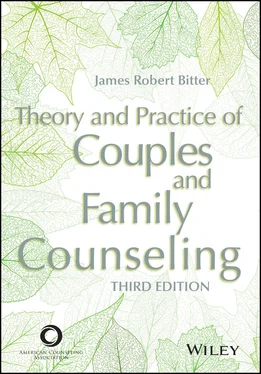James Robert Bitter - Theory and Practice of Couples and Family Counseling
Здесь есть возможность читать онлайн «James Robert Bitter - Theory and Practice of Couples and Family Counseling» — ознакомительный отрывок электронной книги совершенно бесплатно, а после прочтения отрывка купить полную версию. В некоторых случаях можно слушать аудио, скачать через торрент в формате fb2 и присутствует краткое содержание. Жанр: unrecognised, на английском языке. Описание произведения, (предисловие) а так же отзывы посетителей доступны на портале библиотеки ЛибКат.
- Название:Theory and Practice of Couples and Family Counseling
- Автор:
- Жанр:
- Год:неизвестен
- ISBN:нет данных
- Рейтинг книги:5 / 5. Голосов: 1
-
Избранное:Добавить в избранное
- Отзывы:
-
Ваша оценка:
- 100
- 1
- 2
- 3
- 4
- 5
Theory and Practice of Couples and Family Counseling: краткое содержание, описание и аннотация
Предлагаем к чтению аннотацию, описание, краткое содержание или предисловие (зависит от того, что написал сам автор книги «Theory and Practice of Couples and Family Counseling»). Если вы не нашли необходимую информацию о книге — напишите в комментариях, мы постараемся отыскать её.
Theory and Practice of Couples and Family Counseling — читать онлайн ознакомительный отрывок
Ниже представлен текст книги, разбитый по страницам. Система сохранения места последней прочитанной страницы, позволяет с удобством читать онлайн бесплатно книгу «Theory and Practice of Couples and Family Counseling», без необходимости каждый раз заново искать на чём Вы остановились. Поставьте закладку, и сможете в любой момент перейти на страницу, на которой закончили чтение.
Интервал:
Закладка:
The field of psychotherapy in general, and couples and family therapy in particular, is no longer dominated by psychiatrists and doctoral-level psychologists. By far, most couples and family practitioners were trained at the master’s level and completed approximately 2 years of supervised practice before being evaluated and obtaining a license. This dramatic change has taken place in just the past 30–40 years. The number of people seeking psychotherapeutic services is also on the rise. To protect consumers and define professional identities and competence, professional regulations and state laws will become increasingly specific in their definitions and requirements for practice. Although it is impossible to legislate virtue, morality, good judgment, or clinical skills, state laws and professional regulations forge a professional covenant with the public. These regulations are always based on the application of principle ethics—and the principles always reflect the dominant community standards of the state or organization enacting them.
Indeed, state and national laws often take certain moral, ethical, and professional issues out of the hands of the practitioner. Helping professionals in most states, for example, are mandated to break confidentiality and take affirmative, prescribed actions if (a) clients are dangerous to themselves, to others, and in some states, to property; (b) clients engage in or suffer child or elder abuse; or (c) the helping professional is otherwise required to do so by courts in the administration and application of specific laws. Such mandates are considered in law to be so serious that the covenant with consumers requires a consistent outcome every time (i.e., reporting)—even if the outcome can be demonstrated to create more problems than it solves.
State and federal legal requirements have also created standards of care for psychotherapeutic practice. This is especially true for those professions and professionals who must operate under HIPAA requirements and standards. Failure to meet professional standards of practice is the most common grounds for malpractice and incurred liability. It is what makes professional liability insurance a necessity these days and increasingly expensive to purchase.
Summary
Ethical practice is supported by an understanding of ethical principles, virtues, the law, professional codes of ethics, models of ethical decision-making, and you. If you are in the presence of your client, you are engaged in an ethical encounter— from the time you prepare for an upcoming session through the completion of your weekly case notes. During all aspects of the encounter, you have the potential to harm or promote the well-being of your client. An ethical practitioner recognizes the subtle, nuanced ways in which counseling or therapy influences clients. Ethical encounters highlight the importance of personal awareness and presence in therapeutic relationships.
Where to Go From Here
You can access the main ethics codes related to counseling, psychotherapy, and family practice through the websites of the following professional organizations:
American Counseling Association ( www.counseling.org)
International Association of Marriage and Family Counselors ( www.iamfconline.org)
American Association for Marriage and Family Therapy ( www.aamft.org)
Recommended Readings
1 Coale, H. W. (1998). The vulnerable therapist: Practicing psychotherapy in an age of anxiety. Haworth Press.
2 Cohen, E. D., & Cohen, G. S. (1999). The virtuous therapist: Ethical practice of counseling and psychotherapy. Brooks/Cole-Wadsworth.
3 Golden, L. B. (2004). Case studies in marriage and family therapy (2nd ed.). Merrill/ Prentice Hall.
4 Wilcoxon, S. A., Remley, T. P., & Gladding, S. T. (2013). Ethical, legal, and professional issues in the practice of marriage and family therapy (5th ed.). Pearson.
Notes
1 1 Mark Young is a colleague from Gonzaga University. David Kleist is also a colleague of mine, but from Idaho State University. Because Mark and David actually teach courses in legal and ethical issues in couples and family counseling, and I (Jim Bitter) do not, I asked them to help me present the issues and processes that are essential to our work.
2 2 Among other things, HIPAA sets very strict standards for how patients’ medical records may be used. By extension, these requirements apply to any licensed person or group accepting third-party payments and/or filing reports with third parties.
3 3 For an example of such a session in action, see Bitter et al. (2004).

PART 2Theories and Practice in Couples and Family Counseling
INTRODUCTION TO THE CASE OF THE QUEST FAMILY
CHAPTER 5 Object Relations Family Counseling
CHAPTER 6 Adlerian Family Counseling
CHAPTER 7 Multigenerational Family Counseling
CHAPTER 8 Human Validation Process Model
CHAPTER 9 Structural Family Counseling
CHAPTER 10 Strategic Family Counseling
CHAPTER 11 Solution-Focused and Solution-Oriented Family Counseling
CHAPTER 12 Postmodernism, Social Construction, and Narratives in Couples and Family Counseling
CHAPTER 13 Feminist Family Counseling
CHAPTER 14 Cognitive Behavioral Family Counseling
CHAPTER 15 The Science of Couples Counseling
CHAPTER 16 Emotionally Focused Counseling With Couples
CHAPTER 17 Imago Relationship Counseling With Couples
• • •

INTRODUCTION TO THE CASE OF THE QUEST FAMILY
One of the best ways to learn about a theory is to see it in action. Viewing a live demonstration is often the best way to make initial observations about the therapeutic process with families. There are also many useful videotapes and DVDs that allow you to sit in with master therapists at work. 1
I have attempted to give you some of the same kind of demonstration experience through the creation of the Quest family. Toward the end of each theory chapter, I present the Quest family case as if they were seeing a counselor who uses that chapter’s approach. Each example includes dialogue that I hope will give you another opportunity to experience the model in action.
When you read about each theory and practice as it is applied to the Quest family (and to the case presented toward the beginning of each chapter), you might want to ask yourself several questions:
What kind of relationship does the counselor form with the family, and what skills are used to establish that relationship?
What sequences or patterns do you notice both in the descriptions of how the family interacts at home and within the sessions themselves?
How is the family organization affecting their ability to cope with life and handle the challenges they face?
How do family members communicate with one another, and how do their communications reflect family roles and rules?
Where is the family in terms of both individual and family life cycle development? That is, are individual adults facing the world on their own; coupling; forming a family with young children; adjusting to family life with adolescents; launching young adults; coping with divorce, remarriage, or blending families; or handling issues related to aging, later life, and death? Each of these normal developmental experiences tends to cause stress and challenge the family’s resources. How well is the family coping with change?
Читать дальшеИнтервал:
Закладка:
Похожие книги на «Theory and Practice of Couples and Family Counseling»
Представляем Вашему вниманию похожие книги на «Theory and Practice of Couples and Family Counseling» списком для выбора. Мы отобрали схожую по названию и смыслу литературу в надежде предоставить читателям больше вариантов отыскать новые, интересные, ещё непрочитанные произведения.
Обсуждение, отзывы о книге «Theory and Practice of Couples and Family Counseling» и просто собственные мнения читателей. Оставьте ваши комментарии, напишите, что Вы думаете о произведении, его смысле или главных героях. Укажите что конкретно понравилось, а что нет, и почему Вы так считаете.












